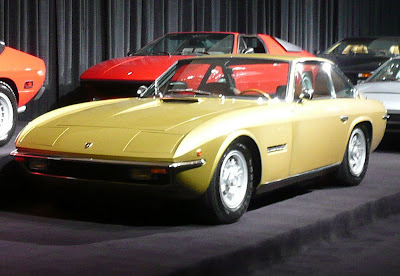After the legendary Carrozzeria Touring closed in 1968, Ferruccio Lamborghini decided to entrust the making of the next model (to become known as the “Islero”) to Touring’s former collaborator, Mario Marazzi. But life was difficult for the Islero with its simple design which was flanked by the spectacular Miura; production ceased after 225 models had been made, of which the last 70 were put on the market in 1969 with a few changes to the body and luxurious interiors in the Islero S version. The Islero was revealed at the 1968 Geneva Auto Show and was named after a Miura bull that killed famed matador Manuel Rodriguez "Manolete" on August 28, 1947.
The Islero was powered by a 4 liter V12 engine that delivered 325 hp. The engine was mated to a 5 speed transmission, fully independent suspension, and disc brakes. Its top speed was rated at 155 mph. Lamborghini made only 125 Islero. In 1969 Lamborghini revealed an updated Islero, called Islero S. It used the same engine that delivered 350 hp, while changes to the car made were: brightwork blind slots on the front fenders, an enlarged hood scoop (which supplied air to the interior of the car, not the engine), slightly flaired wheel arches, tinted windows, round side marker lights (instead of tear drops on the original), and a fixed section in the door windows. Islero S was limited to only 100 units, and compared to a standard Islero it could hit a top speed of 161 mph.
Islero was a very successful model for its era: Ferruccio Lamborghini himself drove an Islero, it also appeared in Roger Moore thriller The Man Who Haunted Himself. In 1975, Paul Rilly entered a modified Islero in the grueling 24 Hours of Le-Mans. It failed to qualify.



 6:11 AM
6:11 AM
 Dewi
Dewi











 Posted in:
Posted in: 






0 comments:
Post a Comment